| Platanus is a genus of 10 very large shade trees, 7 of which are Mexican. Since the 1600s, the Old World Platanus orientalis (Oriental Planetree) has hybridized with the North American Platanus occidentalis (American Sycamore), making vigorous offspring that are at least sometimes fertile. These hybrid trees are called precisely Hybrid Planetrees or Hybrid Sycamores. They are extremely common and familiar. One such was the original London Planetree. But it became outnumbered in London by another hybrid. These days, most people who write about trees are inprecise and call any hybrid the London Planetree. Various clones of Hybrid Planetree exist --some very unlike one another. That is the main point I care to emphasize right now, using pictures. |
| All these trees resemble in leaves many maple trees (Acer species), but the latter have their leaves opposite rather than alternate on the twigs; and longer-stalked; and winged helicopter seeds rather than dry seedballs dangling on a stem. The fall leaf color is also prettier in most maples. |
| In Seattle where I live, our most common kind is 'Pyramidalis' that can be propagted by seed or cuttings. It was known in London by 1850. It is told by making a short, massive trunk that soon divides into widely spreading, stout forks. The original London Plane is a taller, elegant form, with pretty, pale bark. ‘Pyramidalis’ trunks are swollen, burly, dark and brutish; their upper limbs show some pale green to mustard-colored bark. 'Pyramidalis' leaves are shallowly lobed. |
Annoyingly, over the centuries, different scientific names have been used to describe these hybrid trees:
|
Platanus × hispanica Mill. ex Muenchh. 1770
|
Platanus × acerifolia (Ait.) Willd. 1805
|
Platanus × hybrida (Ait.) Brot. 1804
|
Platanus × intermedia hort. 1838
|
Platanus orientalis hort. (in part), non L. 1753
|
Platanus orientalis var. acerifolia auct. 1789
|
(Platanus orientalis × Platanus occidentalis)
|
| The Oriental parent has leaves that are elegantly and deeply lobed, and makes (2) 3–4 (6) smaller seedballs; the USA parent has leaves with three large lobes, and makes 1 or 2 large seedballs. Their hybrid offspring are in between. Also, in London, the American grew weakly and never ripened seedballs. The Oriental tree grew, but could not be raised by cuttings. So English nurserymen got their stock from coninental Europe. That is where the London Planes originated. At least some such clones strike readily from cuttings. The hybrids achieved their fame by easily tolerating adverse urban conditions such as the stifling black soot of industrial London. |
| Seattle’s common old clone 'Pyramidalis' has (1) 2 (3) seedballs. The tallest in town, in forested Interlaken Park, is more than 100 feet. Most are short but extraordinarily wide. See my photos below. |
| Robert Van Pelt measured the largest hybrid in Walla Walla 121.5 feet tall and 126 feet wide in 2023, and the largest 'Pyramidalis' there 89.5 feet tall and 130 feet wide. |
In Seattle, the prettier, taller, paler-barked form closer to the original London Plane, is extremely rare. The finest specimen I know is right by the street at 6007 NE Windermere, and stood 97 feet in 2020 so by now is over 100 feet tall. The mansion there was built in 1930, so the tree dated from sometime thereafter. Below I show a Google® image from May 2019, and a photo I took in October 2020. I sure wish this form, rather than 'Pyramidalis' was Seattle's common hybrid.
Back |
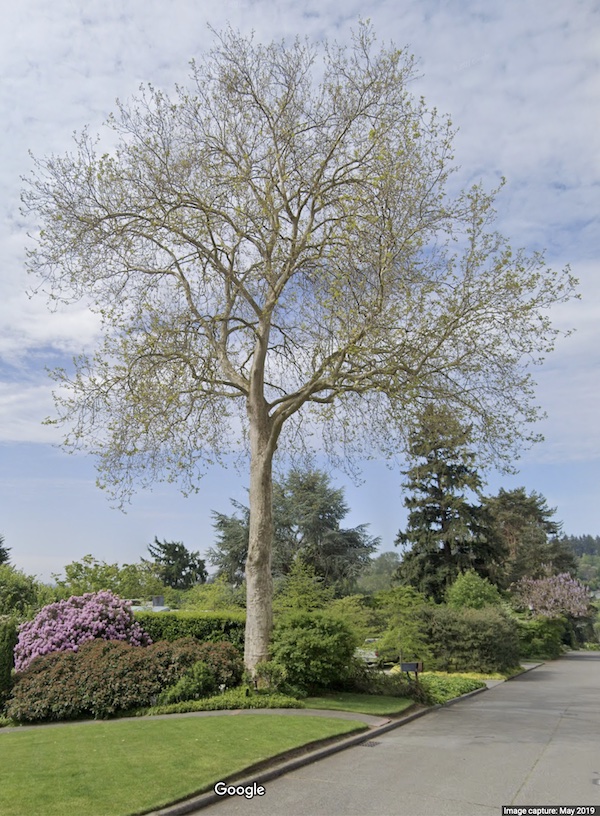
Windermere hybrid Planetree ; photo by Google® May 2019
|
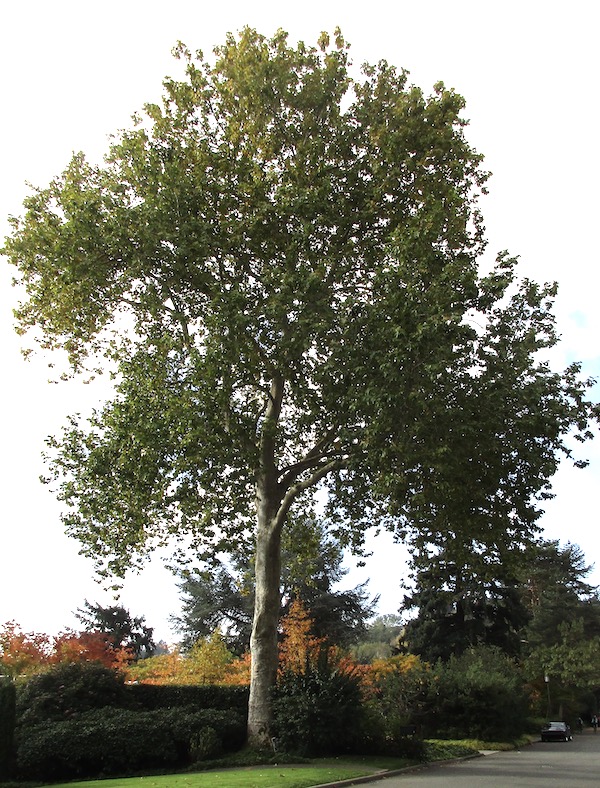
Windermere hybrid Planetree ; photo ; photo by ALJ October 2020
|
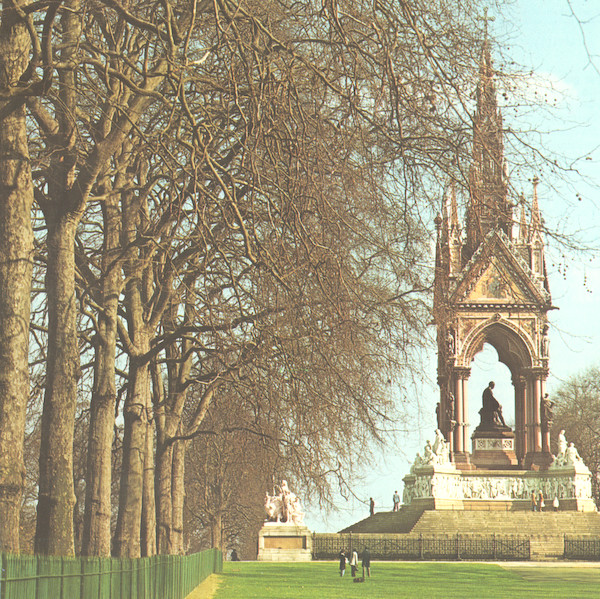
Hybrid Planetrees in London at Hyde Park ; photo from The Oxford Encyclopedia of Trees of the World ed. by Bayard Hora 1981
|
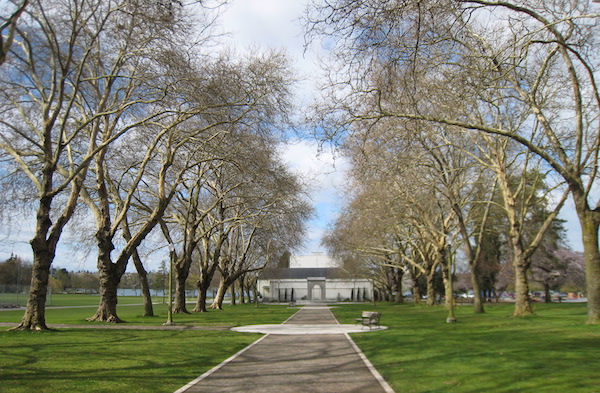
'Pyramidalis' Hybrid Planetrees at Seattle's Green Lake ; photo by ALJ March 2010
|

'Pyramidalis' Hybrid Planetrees at Seattle's Green Lake ; photo by ALJ September 2017
|
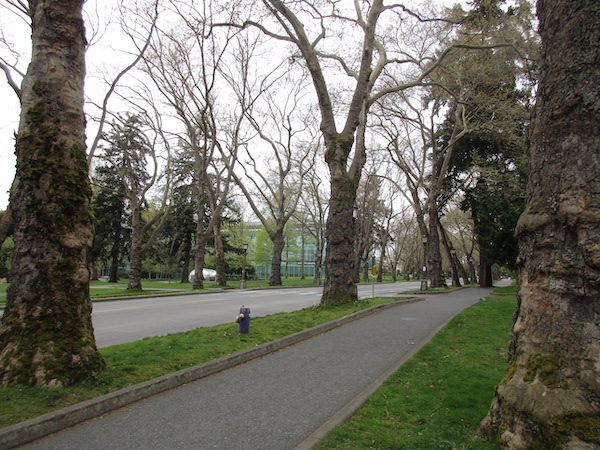
'Pyramidalis' Hybrid Planetrees at Seattle's UW campus Memorial Way ; photo by ALJ April 2024
|
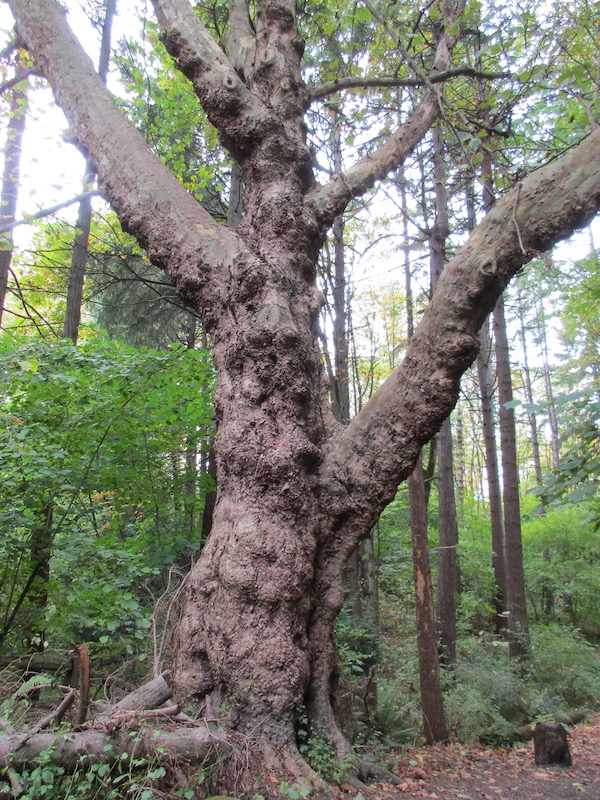
'Pyramidalis' Hybrid Planetrees at Seattle's Interlaken Park ; photo by ALJ October 2016
|

'Pyramidalis' Hybrid Planetrees seedling from Seattle ; photo by ALJ September 2021
|

